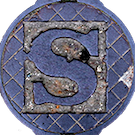Digital Scientific Notations: Difference between revisions
No edit summary |
m (Another link fix) |
||
| (One intermediate revision by the same user not shown) | |||
| Line 1: | Line 1: | ||
A scientific notation is a convention for encoding scientific information using symbols. The best known example is mathematical notation. The goal of a scientific notation is to represent scientific knowledge in a way that humans can easily comprehend and manipulate. While in principle a mathematical equation could be replaced by an equivalent statement in plain language, the more concise equation is faster to read (assuming a trained reader) and allows manipulation by formal rules (such as "add the same term to both sides"). | A scientific notation is a convention for encoding scientific information using symbols. The best known example is mathematical notation. The goal of a scientific notation is to represent scientific knowledge in a way that humans can easily comprehend and manipulate. While in principle a mathematical equation could be replaced by an equivalent statement in plain language, the more concise equation is faster to read (assuming a trained reader) and allows manipulation by formal rules (such as "add the same term to both sides"). | ||
A '''digital''' scientific notation is a scientific notation that can be processed by both humans and computers. A machine readable notation is necessarily a [ | A '''digital''' scientific notation is a scientific notation that can be processed by both humans and computers. A machine readable notation is necessarily a [https://en.wikipedia.org/wiki/Formal_language formal language] and thus has a well-defined unambiguous syntax in addition to some useful level of well-defined semantics. | ||
There are many formal languages designed for representing scientific information. An example is the [ | There are many formal languages designed for representing scientific information. An example is the [https://en.wikipedia.org/wiki/SBML Systems Biology Markup Language (SBML)]. Most of them do not qualify as digital scientific notations, because they are designed to be used by software but not for communication between humans. | ||
There are also formal languages that are designed to be read and written by humans, in addition to computers. Programming languages are the most prominent examples. In scientific computing, programming languages are routinely used to represent scientific knowledge as program code. In particular, computational notebooks embed code written in high-level programming languages such as Python or R into a narrative, much like mathematical notation is used in traditional scientific publications. However, programming languages fill the role of scientific notations rather poorly, in particular because they cannot express anything other than executable algorithms. | There are also formal languages that are designed to be read and written by humans, in addition to computers. Programming languages are the most prominent examples. In scientific computing, programming languages are routinely used to represent scientific knowledge as program code. In particular, computational notebooks embed code written in high-level programming languages such as Python or R into a narrative, much like mathematical notation is used in traditional scientific publications. However, programming languages fill the role of scientific notations rather poorly, in particular because they cannot express anything other than executable algorithms. | ||
Latest revision as of 05:35, 11 November 2022
A scientific notation is a convention for encoding scientific information using symbols. The best known example is mathematical notation. The goal of a scientific notation is to represent scientific knowledge in a way that humans can easily comprehend and manipulate. While in principle a mathematical equation could be replaced by an equivalent statement in plain language, the more concise equation is faster to read (assuming a trained reader) and allows manipulation by formal rules (such as "add the same term to both sides").
A digital scientific notation is a scientific notation that can be processed by both humans and computers. A machine readable notation is necessarily a formal language and thus has a well-defined unambiguous syntax in addition to some useful level of well-defined semantics.
There are many formal languages designed for representing scientific information. An example is the Systems Biology Markup Language (SBML). Most of them do not qualify as digital scientific notations, because they are designed to be used by software but not for communication between humans.
There are also formal languages that are designed to be read and written by humans, in addition to computers. Programming languages are the most prominent examples. In scientific computing, programming languages are routinely used to represent scientific knowledge as program code. In particular, computational notebooks embed code written in high-level programming languages such as Python or R into a narrative, much like mathematical notation is used in traditional scientific publications. However, programming languages fill the role of scientific notations rather poorly, in particular because they cannot express anything other than executable algorithms.
Digital scientific notations are not computational tools, but parts of the communication interfaces between scientists and their computational tools. In particular, they permit scientists to discuss computational models and methods in a way that ensures conformity between the human narratives and the computations.
Further reading: Scientific Notations for the Digital Era (on arXiv)
Discord
That said, the more abstract idea of defining a data model plus execution semantics that any programming language can plug into looks very promising. That aspect of WikiLambda was in fact one of my inspirations for developing Digital Scientific Notations.
